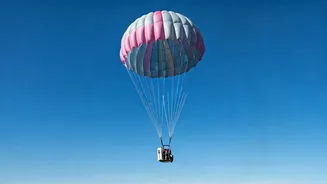Gaganyaan's Flight Tests
The Indian Space Research Organisation (ISRO) is in the process of conducting crucial tests for the Gaganyaan mission, a groundbreaking project aimed at sending
humans into space. As part of this, ISRO plans three uncrewed test flights. These flights are designed to simulate the conditions of a human spaceflight and gather essential data to ensure the safety and success of the crewed mission. This approach demonstrates ISRO's commitment to careful planning and extensive testing before undertaking the ambitious goal of sending Indian astronauts into space. These tests are vital for identifying and rectifying any potential issues, thereby increasing the probability of a successful manned mission.
Vyomitra: Space Friend
A significant element of the uncrewed missions is the integration of Vyomitra, a half-humanoid robot. The name 'Vyomitra' is derived from Sanskrit and translates to 'space friend.' This advanced robot is designed to play a crucial role during the test flights by gathering data on various parameters essential for human safety. Vyomitra is equipped with sensors and systems that will monitor conditions within the spacecraft, such as radiation levels, air pressure, and the overall environment. The data collected by Vyomitra will be instrumental in validating the design and ensuring the crew's safety in the eventual manned mission. Vyomitra is more than just a data-gathering device; it's a testament to India's technological advancements in space exploration, and its performance will provide crucial information.
Uncrewed Flight Objectives
The primary objectives of the uncrewed test flights are multifaceted, each contributing to the overall mission's success. These flights aim to validate the performance of the spacecraft's systems under spaceflight conditions. Data collected is crucial for verifying the integrity of the life support systems, environmental controls, and other critical components necessary for the survival and comfort of astronauts. The tests will also assess the performance of the launch vehicle, the orbital parameters, and the re-entry process. The information gathered during these tests will be used to fine-tune the spacecraft's design, making necessary adjustments to improve its performance and reliability before sending humans into space. The uncrewed flights are, therefore, a crucial step to reduce potential risks and confirm the mission's viability.
Parachute Test Success
ISRO recently conducted crucial parachute tests in preparation for the Gaganyaan mission. These tests are essential to ensure the safe recovery of the crew module after its return to Earth. The successful completion of the parachute tests provides confidence in the design and deployment mechanisms of the parachutes. They are used to slow the spacecraft's descent through the atmosphere, providing a safe landing for the astronauts. The parachutes must deploy reliably and effectively under various conditions. Success in these tests demonstrates ISRO's commitment to thorough preparation and rigorous safety standards for its human spaceflight mission. These tests involve deployment at different altitudes and speeds, simulating the conditions of re-entry. The tests are a critical component of the Gaganyaan mission's safety protocols.
Future Mission Prospects
The Gaganyaan mission represents a significant milestone in India's space program. It is envisioned that after these uncrewed flights, the human spaceflight mission will take place. This mission will mark India's entry into the select group of nations that have sent humans into space. The knowledge gained from Gaganyaan will pave the way for future space exploration endeavors, including potential missions to the Moon and beyond. Gaganyaan's success will inspire future generations of scientists and engineers, fostering a spirit of innovation and scientific curiosity across India. The mission's infrastructure and technology will also boost domestic space capabilities, establishing India as a leader in space exploration.















